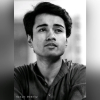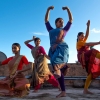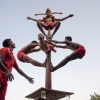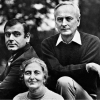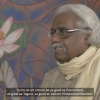Madhavi Mudgal is one of the acclaimed Odissi dancers today. Born in 1951, and growing up in a culturally inclined family in Delhi, Mudgal gravitated to dance and music from a very early age. She was trained in Bharatanatyam and Kathak but after watching an Odissi performance by Sanjukta Panigrahi and Kumkum Mohanty in Delhi, she was instantly drawn to the beauty and lyricism of the dance and began to train under Harekrishna Bahera. Later, she became the disciple of the legendary Odissi guru Kelucharan Mohapatra, and under him she blossomed into an exemplary dancer. She has performed on innumerable stages nationally and internationally. She has been at the forefront of steering the nascent classical dance form of Odissi to greater heights and bourgeoning its popularity by conducting workshops and concerts. Her choreographies received critical acclaim in reputed dance festivals across India and abroad. She has been honoured with the Padma Shri, Sanskrit Award, Sangeet Natak Akademi Award, 1996, Grande Medaille de la illa by Government of France, Central Sangeet Natak Akademi Award, Delhi State Parishad Samman, and she was also conferred with the title of Nritya Choodamani in 2006.
Following is an edited transcript of the first segment of the video interview with Madhavi Mudgal conducted by Madhur Gupta.
Madhur Gupta (MG): Madhaviji, tell us about where it all began—your early life, your life in dance?
Madhavi Mudgal (MM): I was born in a musical surrounding. All around me I had music and dance because, in 1939, my father started the Gandharva Mahavidyalaya in Delhi in the tradition of Pandit Vishnu Digambar Paluskar, the great revivalist of Indian music. Delhi, at that time, was not really a place for classical music and dance. There was no culture of learning classical music or dance because it was not considered respectable. So, our house in Connaught Place was where the classes were held. All the musicians from Pune, Bombay, Maharashtra, Kolkata, etc., came and stayed with us, so I grew up listening to them, listening to their discussions. That is where I was born, and I was lucky. But since childhood I was somehow more interested in dance. I would be found in dance classes and not in music classes. It was natural that I took to dancing.
MG: So Gandharva already had a dance faculty then?
MM: Pandit Narayan Prasadji of Jaipur Gharana was teaching there. A fine exponent of Jaipur Gharana. Then Tirath Ram Azadji was there. And Durgalalji was there later.
MG: You first learnt Bharatanatyam and Kathak, didn’t you?
MM: Yes. Those were the two classes happening at that time, so I was learning both more like fun, because I loved to dance—thrice a week for Kathak, thrice a week for Bharatanatyam. Of course, I learnt them for many, many years. I didn’t pursue Bharatanatyam, but Kathak I did, at a professional level.
MG: Yes, definitely. You were performing with Durgalalji himself.
MM: Yes, we were doing duets, and he was such a star.
MG: You were renowned as a Kathak dancer already.
MM: Then I started training in Odissi because I saw an Odissi performance in Delhi. I saw Odissi at Sapru House. There was no Kamani Auditorium in the 60s. In Sapru House there was this performance of Kumkum Mohanty and Sanjukta Panigrahi. When I saw their performance, I was fascinated by the form because, I think, for what my personality is—I wanted something really subtle. Odissi was so lyrical and so beautiful and so sculpturesque. And, by chance, Hari Babu or Harikrishna Behera Guruji came to teach at our institute. It was in the late 60s, I think.
MG: But how did it happen? I mean, Harikrishna Beheraji was here on a scholarship to learn Kathak from Birju Maharaj, I guess.
MM: That is right. And he also had a school in Gole Market.
MG: He was teaching Odissi, and learning Kathak from Maharajji, and so Gandharva Mahavidyalay invited him?
MM: He had done a course at Kala Vikas Kendra.
MG: With Kelu Babu?
MM: Yes. He had learnt Odissi with Guruji, and then he came to Delhi, and that is how I started learning under him, under Guru Harikrishna Behera. He taught me the basics in Odissi. So, when I got more into Odissi, I realised that I had to do only one style. I was performing Kathak and I was learning Odissi. And I realised that to do it really well, to really go deep into it, I had to do only one style. I think that also came from my musical background, when I saw all the greats of Indian music—Pandit Omkarnath Thakur, Pandit Vinayakrao Patwardhan, Gangubai Hangal, Pandit Jiwan Lal Mattoo, Dilip Chandra Bedi etc.—discussing music every evening. Not that we understood anything, but we realised the depth any of these art forms demanded.
So, I decided to give up Kathak completely. Although it was far more difficult to do Odissi at that time. There were no musicians, there was hardly any appreciation for it.
MG: In which year was Odissi recognised by the Sangeet Natak Akademi?
MM: Officially, I think, in 1957, but this official recognition doesn’t mean anything. It has to be performed in public, and people have to view it and then accept it.
So Indrani Rehman was really the first one who performed Odissi as a part of her whole evening’s repertoire of performance, alongside Bharatanatyam, Kuchipudi and Mohiniyattam. Then even Yaminiji did a bit of Odissi. And Sonalji was also performing Bharatanatyam and Odissi on stage. But on stage, I didn’t, except, I think, one evening I did all three styles, like 45 minutes of each style, not one item. But I thought I had to do only Odissi to go deeper and find myself in it.
MG: And how did your shift or transition from Harikrishna Beheraji to Kelucharan Mohapatraji happen?
MM: That is a very interesting incident. Hari Babu was a disciple of Kelucharan Mohapatraji. So, I had a performance in Bombay, Solibhai Batliwala was organising it and Hari Babu was supposed to come because he used to accompany me on pakhavaj (a percussion instrument), the singer was Raghunathji. There were no Odia singers at that time, except one or two, and Raghunathji only sang for me.
The performance was scheduled, and it was, I think, monsoon time and the train from Delhi got cancelled—the train which was bringing Hari Babu to Bombay. Then Pandit Bhuvaneshwar Mishra was going to accompany me on the violin because most of the compositions were his. He told me that Guru Kelucharan Mohapatra happened to be in Bombay at that time, so he said: Why don’t you request him to play for you? I did and he agreed. Can you imagine? I think no other dancer must have done this except probably some Kathak dancers. Without a single rehearsal—he had not even seen me dance—he played for me. Till the afternoon we didn’t know whether he was coming or not. He played the pakhavaj, and I can’t tell you the feeling I had when I danced to the accompaniment of his music.
MG: Which year was this?
MM: I think 1972, if I am not wrong. Then after that I started training with him. So, I would go to Orissa, stay with him for two to three months, and then he would come to Delhi. At that time, he was not so busy.
MG: But then, did you ask Harikrishnaji before going to Kelucharan Mohapatraji?
MM: Yes, yes, of course. I took his permission.
MG: What was his reaction?
MM: Initially he was not too happy because each guru trains you with all his heart and all his dedication, and brings you up sort of, and then suddenly you leave. But this was done traditionally. My father, he himself would train students and then send them to some famous guru. So, he also asked Harikrishnaji, and then finally he agreed, and he was later very happy with it.
MG: So Madhaviji, what made you abandon everything else in your personal and professional life and choose Odissi as the object of your lifelong devotion?
MM: Yes, looking back, I was studying architecture, I could have been an architect. I was dancing Kathak at a very professional level, different places in India, abroad, in solos and even accompanying as a partner to Durgalalji. I wanted to go deeper into Odissi despite it being a bigger challenge because there were no musicians, people didn’t know what Odissi was and there were no full-length performances that were really happening seriously like we could do a full evening of Kathak. But Sanjukta Panigrahiji did a full length proper recital of Odissi, and I thought I must also just concentrate on Odissi to go deeper, and to be able to justify my passion for it. You know, it can’t be done casually. So, I left my architecture degree and I left Kathak to only do Odissi.
MG: Retrospectively thinking, what barriers do you think you have broken in the genre of Odissi?
MM: Well, looking back, I was lucky to have had a background in other styles, and I was lucky to be with Guruji [Kelucharan Mohapartra] at that time, in the early 70s, because even he himself was working out a pedagogy, the system of teaching, at that time. So, I consider myself really lucky. He was not busy then like he became in the late 70s and early 80s. So, we spent a lot of time together working that out. Because of the background of my training in other styles, I thought there should be a more systematic way of learning and teaching. I was not teaching at that time, I was just learning. So, these were not barriers but challenges which were actually, in a way, good because I could go deeper into the style, and work out those things. Guruji of course worked them out but I was with him at that time. And I didn’t teach till 1984-85, and that too because when he told me to. Because I didn’t think I was ready to teach. But he said: No, you must teach because you will learn when you teach. This is so true. When I teach now—I have been teaching for so many years—I realise that when you teach, you face a challenge with every student, every student is different, every body is different. So, how you can mould it according to the dictates of a style is important. And Guruji was an expert at that. Sanjuktaji was completely different from Sonalji or Kumkum or myself; we were all different. We all followed his style, of course, but we had different personalities. Even if we did the same item, it looked different. These were the challenges. Musicians, their repertoire. There were not so many items when we started learning. So, we had to build up the repertoire. I started composing pieces for myself, I mean, either my brother or my father, they would compose the music. We had the example of Pandit Bhubaneswar Mishra in front of us. My pieces were based on what they did. Every single pallavi was in a particular Hindustani raag or Carnatic raag. So, they were raag based. Obviously Odissi music was there, but if you really analyse, everywhere there is Hindustani music. If you see Bengal which is on the other side of Orissa, Bengalis also sing classical music, their classical music is Hindustani. In Andhra, or you go down to Karnataka, their language is not Hindi but they sing Hindustani music, all great—a lot of them, not all—Hindustani musicians are from the Dharwad region. Hindi is not their language. So obviously this music was also prevalent in Orissa. At that time all the musicians of Orissa were learning Hindustani music. Be it Sunanda Patnaikji or Mishraji. Raghunath Panigrahiji had learnt both Hindustani and Carnatic because it had influences of both. And, of course, there was the traditional Odissi music or their traditional songs. They are so beautiful, but they may not be in a particular raag. But if you have to compose something, the background, it had to be in a raag, it couldn’t have been just anything. The raag and the taal, these are the truths of music. Raag is only a structure. So, if you see all our ashtapadis, they were all Hindustani raags—Des, Khamaj, Kaafi, Yaman, etc. When I started learning, these were the raags being used. So, I didn’t see that it was a barrier to compose something. This, later on, in the late 80s, when this great consciousness of Odissi music came about, even then they all did Hindustani music, for example, Gopal Chandra Panda Sir, and they were from the background of Orissa, so they knew traditional Odissi music. Now they are trying to revive some raags but as a performing art in Odissi music. Very recently they have started singing them, but it is more composed, more fixed. A raag can only be when it is possible to travel around in it, which is happening now. Hopefully, like Odissi dance, traditional Odissi music will also come of age. But my pieces were in a particular raag, call it Hindustani.
MG: How much has the approach, in terms of technique, style and the intention, changed in Odissi dance? There is a style which Kelu Babu used to teach and all of you used to do. And what we see now, as you know, is very different.
MM: Yes, I think, any style is constantly evolving in whichever direction. I think, when I started learning, it was more necessary to establish it as a classical form. So, I think, Guruji’s intention was very much to put it in a classical frame, to be more natyadharmi (here, it means dance that pertains to the conventions of stage) than lokadharmi (realistic). So, you see, all the beautiful ashtapadis that he composed. And if you see what gotipuas (young boys dressed as girls and dancing in praise of Krishna) were doing, they were doing their pallavis, but they didn’t know what svar it is but they were just doing it simply. So, from such a background, Guruji made such evolved pieces of nritta (pure dance). Because taal is nobody’s personal domain. It is all about how you can play with the laya and the taal structure. So, he was a pakhavaj player himself. He had such a mind that he could compose these very beautiful, intricate and evolved nritta pieces that he choreographed. I would go to the extent of saying that, everybody may not agree with it, what we know as Odissi today, is completely based on what he did. Majority of dances are in his style. Even other styles take inspiration, to some extent, from what he has done. He made the base for the dance; he was the main architect. Of course, he was a disciple of Guru Pankaj Charan Das and learnt from him. Most of the other Odissi gurus, the next generation, learnt from Guru Pankaj Charan, Guru Debaprasad Das and Guruji. So, it was an amalgamation of the teachings of these three great gurus.
MG: But when we talk about intention, like when we see Guruji’s choreographies, the grace and elegance they have, and now when we see the new choreographies or not even new choreographies, the same old choreographies done by dancers, the way in which they do, the intentions with which they do, we feel that that has changed. I am not saying it is bad or good.
MM: It has changed. I would certainly say that because—take the the basic tribhanga, the very central position with the torso movement—now it is more horizontal kind of torso movement. The tribhanga has gone way beyond the central plumb line, and that is a style that has been mastered by some dancers and is being perfected and performed. And why not? I mean a variety of style is most welcome. But I think that period was very beautiful. The grace and elegance, the flavour of that form which attracted me, was of that style. It has a very controlled torso movement, very controlled other body movements—not exaggerated or not very stiff, in line and has a natural flow. But, I think, every generation, this way or that way, will progress, it cannot remain stagnant.
Another thing maybe I should mention is that when I was learning the form and performing in Orissa, I think in 1976, I gave a performance where both the gurus, Guru Pankaj Charan Das and Guru Debaprasad Das, were present. And imagine a student of another guru performing, and these gurus were there and they were very, very happy too. So, I was blessed, that, I think, was the biggest blessing I had had. There were not too many Odissi dancers at that time who were really into the dance. Sanjuktaji was there, Kumkum Mohanty was there, but Kumkumji left for many years for the IAS, and Minatiji was there, but then she, too, left. Sonalji was, of course, there.
So, I think, these gurus saw something in my dance and they were very happy.
Another thing I would like to mention is that, in 1985, I did a festival called ‘Angahar’, which was the first-ever Odissi dance festival. Actually, it brought together all the possible entities like the gotipuas, the maharis for the first time in Delhi. We got Dungri Mahari Haripriya Debi to come, and Guruji played the pakhavaj and she did some simple abhinaya sitting down, which was very beautiful.
Then even the first Odissi dancer who brought it to Delhi—Priyambada Mohantyji. She had not danced for many years. She had taken up Zoology, but I requested her and she agreed to perform. Minati Mishraji too came. So, we had all the greats. Sanjuktaji, Minati Mishraji, Kumkumji (Kumkum Das at that time, later she became Kumkum Mohanty), all these senior-most, first-generation dancers of Odissi, all the gurus, all the second-generation gurus— Gangadhar Pradhan Sir, Ramani Ranjan Jena, etc. And then we had seminars with Mohan Khokharji, Kapilaji and all the gurus, and they did their demonstrations in the morning just so the people of Delhi realise that there were different styles even in Odissi.
I think it was after that, it may or may not be true, but Guru Debaprasad Das’s style started being recognised in this part of the country. They went to Khajuraho—Sangeeta and Sujata Misra—they were such beautiful dancers. What Indrani performed was in Deba Sir’s style, but it was just one item. And even in a Sangeet Natak Akademi seminar, Deba Sir’s student performed, but she did more of those acrobatic things. So, I think, Angahar is a landmark in the history of Odissi dance.
MG: I would like to ask what made you do it and why?
MM: I wanted to know about the other styles. I mean, you just see one performance, and that is not enough. I wanted to interact with the gurus and wanted to know the taals of Odissi. I wanted to know more about the hastas (hand gestures) of Odissi. So, keeping that in mind, I had interviewed all the gurus. The seminars were arranged for that purpose so that I can understand and also the Delhi audience understands. In the mid-80s, the Delhi audience was very vibrant, very solid. Imagine four days—morning, evening, noon and night—the Kamani auditorium was absolutely full. First people said: Oh, who will come for four days, five days for only Odissi. But it made such a huge impact.
Also, in terms of photography, in bringing out a commemorative volume, it was like a book, we didn’t use any ads, we used photographs of sculptures for the ads and we photographed each and every dancer and each and every guru—they were not readymade pictures. Some of these gurus dressed up after so many years! It was very touching. Most of the books written after that have those pictures of Avinashji’s, not recognised by most, but because it was Angahar festival, people remember. So, I think, it was a landmark festival that brought in a lot of focus to Odissi.
MG: I would like to ask you what makes Odissi ‘Odissi’—in terms of what we see now as successful dance companies and the very original, old style, old Kelu Babu style. So, where does the paradigm shift happen that this is Odissi and this is not?
MM: That is very difficult to say about any style. You see, if you really analyse, what is happening in Kathak or even in Bharatanatyam, these shifts keep on happening, it is for each artist to value the right things. And what are the right things for me may not be the right things for another person. Oh! this is too boring, it is too slow. Oh! it is too subtle. Each one to themselves. You cannot say this is right and that is wrong. But there are some fundamentals of the form. Like, in music it is easy. In music performances you have the tanpura playing, if you are slightly besura (out of tune), you cannot make it. Some sort of basic level is there. In dance, how do you recognise that? What is the correct chowk (one of the basic standing positions in Odissi)? What is the correct tribhanga? What is not correct? A betaal (out of rhythm) you can make out, but now you have so many betaala dancers doing so well because there is no discrimination, there is nobody to point it out. That is why in dance there is more mediocrity. In music, if you have to sit and sing and do an alaap, you just can’t do it if you don’t have it in you. In dance you can wear a costume and dance—either good or bad, you can perform. So, the truth is that it is difficult to set a standard, and most dancers don’t even realise it. And the gurus are not there to guide you well.
MG: Odissi is a very graceful, I would not say feminine, dance form but also lyrical. There is precision but there are never straight lines in Odissi. But then why do you think that a sense of masculinity and lot of, what I mean to say, strength come in the productions of all these new renowned companies?
MM: Your own aesthetics. I mean, how can you have a straight line in Odissi? I mean, I wouldn’t. If you see the whole culture of Orissa, you see the language, you see their sculpture, you see the textile, you see the way they sing, everything has this circular, spiral feel to it. So, if it is there, it is coming from your own aesthetics. I mean if you want to dance because you want to be successful or that is what people like, it is your own choice. And maybe you really like that. I don’t know. Obviously, otherwise they wouldn’t be doing it.
MG: Could we talk about your choreography in comparison with your guru’s choreography?
MM: I think, all I do now, every single choreography, emerges from what Guruji taught me. You cannot see it probably in so many direct terms but the drishti (sight) he gave me in terms of the movement, he was a very methodical teacher, I carry with me. Each little thing had to be just so when he taught. So, I imbibed that, and what I create now comes very much from that, very much from the musical roots, very much from what was my base in dance. So, as I said, these three truths of taal, laya, svara, that form of the dance that I learnt, the style I was taught, I do whatever I do from that. Also, I think, my training in architecture has helped me in terms of dealing with space, because architecture is also designing in space, sculpting space. So that, too, has helped me. So, my choreography has all these elements, and, I think, they are as contemporary as they are traditional.
MG: What do you think your stronghold is when it comes to choreographies?
MM: What my strong point is, the audience has to say. They have to judge and say that. But, I think, for me, this dance drama genre doesn’t attract me too much. Even if I am doing something with abhinaya, it is not like one Krishna or one Radha, the characters are not sort of there. Even if they are there, the same person who is performing their roles can assume some other character too. So, it is more the solo form performing multiple characters with, of course, images and not the dance drama that attracts me in choreography. And, of course, the taal structures attract me a lot because there is so much that you can do with taal, with multiple bodies, with multiple layers, and that is not possible in solo. So that possibility I try to bring out in a group work. Of course, the spatial form covering space, covering or sculpting multiple images in space, that happens in a group, but it should have meaning, not just in abstraction, there has to be some idea behind it. So, I love to explore multiple-layered taal structures through my work. And the philosophical content which we can do in abstract form, not literal.
MG: As you said once and I am quoting you: ‘The soul of classical dances lies in solo’.
MM: Absolutely.
MG: When you see a soloist perform, what characteristics should a discerning audience look at or look for in the dancer?
MM: I would put it the other way, what should a dancer aim to project and not what the audience should look for in a dancer. The audience is there, they will receive anything that you give. So, it is the duty of the dancer to offer to the audience the essence of the form through the performance. And there are so many things that go into making a dancer, a soloist. I mean, in any classical form you need to have, of course, the basic learning of the technique—training and technique. Honing your body, it takes many, many years, at least ten to twelve years to get the form set in your body. That is when you start to learn. And you have to have a sense of music. I mean, you can’t also learn music or master both music and dance, but you have to have at least a basic knowledge of taal, of music. A good teacher will always train you in the taal structures also, and then literature—so, different aspects. Of course, aesthetics, costume, make-up, these are superficial things, but also very important things. Conditioning your body, keeping your body in shape. If you are on stage, there is that duty you owe to the audience, to yourself, to the form. So, too many things go into the making of a dancer. That is why you don’t have too many soloists. Many dancers are there but quality dancers are not that many. You see there are hundreds of Odissi dancers now but how many can actually hold the attention of the audience for two hours without their straining minds. When we started performing in the 80s, we used to do a full two hours programme, two ashtapadis, two Odia songs, two pallavis and battu, which has completely gone out now. So, this whole sequence we used to do. We were lucky at that time because we got the opportunity. Now people are asked for short dance pieces—15 or 20 minutes. How can they ever excel themselves? Even those who have the capability of being a soloist get very few chances.
MG: You would agree that dance demands a lot out of your life.
MM: Absolutely. You cannot dance and do a lot of other things. Maybe nowadays people are all multitasking, but, I think, if you are dancing, you need to only dance. I mean, it requires a lot from you, you know, like body training, understanding of the other forms, other arts, etc. I mean, you see dancers, they don’t go to watch a theatre performance, they don’t go to listen to concerts. I don’t think that is right because every single experience of an evolved form, even a good film, gives you a rounded perspective. So, it is important to keep your eyes open too. You know, to love a sari or a weave or to see good colours, good forms, architecture, films, theatre, music—everything.

